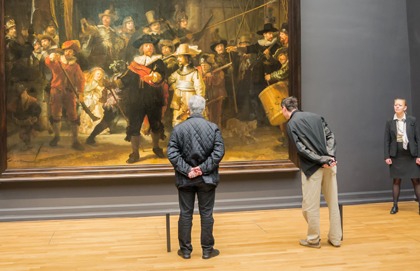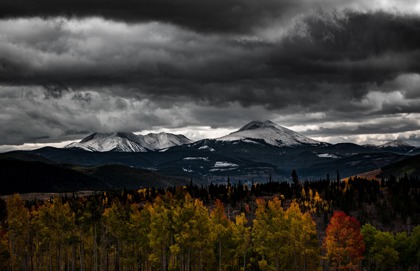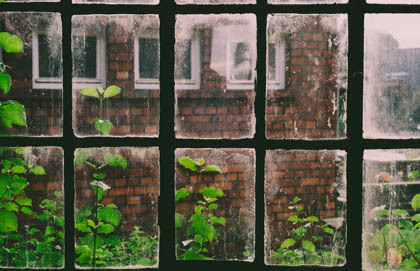Can you find God in a Monet?
I hate the question and its kind. Even when well-intentioned Christians ask it, the question belies a ham-fisted approach to all art as some utilitarian vehicle to the Divine. As if Crane and Waugh, Picasso and Turner, Wagner and Bach are all “up to” the same kind of thing. Yet perhaps the question is so often asked by well-intentioned Christians today because they feel at odds with the flattened secular culture in which they live, and they wonder: might art stir up a longing for the Divine when so much else in life seems flat?
Many who trundle through the Musee D’Orsay—that cathedral of the aesthetic—rarely ponder such a question. Sure, one might experience wonder, dread, melancholia, or joy in the presence of such great works of art: but do such responses nudge us, in any way, towards God? Should they?
Getting an answer to such questions is what drew many to the Art Gallery of Ontario this week to hear Charles Taylor provide his signature (i.e. sprawling and ambitious) ruminations on a stunning new exhibition, “Mystical Landscapes.” The collection features some works of Van Gogh, Carr, Munch, Turner and many more—including, of course, Monet. The special grouping was centred upon the interconnections between art and the “spiritual,” examining how the various artists were inspired by their religious beliefs and how, in turn, such beliefs might also direct various viewer receptions.
There are few people better poised than Taylor to explore how we might seek out traces of God through art today. He has become one of the best Virgilian guides to our current moment, focusing a great deal of his formidable word-hoard to understanding how individuals and communities maintain belief in this “secular age.” What’s most refreshing about Taylor’s work, as was evident in his talk, is that he refuses the despair that characterizes many religious alarmists by discounting the premise that unbelief is the inevitable road upon which we are all progressing. He also never lets the simple caricature of the age override the nuances and complexities of the full picture.
When asked if beauty will eventually replace religion, Taylor simply stated that for some it might, and for others it already has; but for a large group of people it likely won’t. That it’s become an option in the past century or so, though, bears our attention. In other words, there seems to be no clear path that all—let alone any—of us is moving upon today. What we find is an increasingly fractured, globalized world where new and conflicting options abound like never before.
In Taylor’s framing, the secular is best understood as a complex set of conditions that affect believers and unbelievers. Within these conditions, wrought in part by the Christian church, unbelief becomes a much easier and increasingly more likely option than it was, say, five hundred years ago, while belief becomes more difficult. But this is also to say that a nudge towards belief is not impossible and there are many signs in the immanent frame—the strictly materialist universe that has clipped the hidden God from the picture—of a growing sense of malaise that may open up hopeful possibilities. (If you want the full story as to what those conditions are and how, over five centuries, we “accomplished” them in the West, you’ll have to set aside a few dozen afternoons to read A Secular Age.)
Most of this was background, though, to Taylor’s main focus, which was poetic language. Jumping in to the conversation around the time of German Romanticism, Taylor helpfully unpacked how the Romantics reacted against the increasingly materialist vision of the world in the late 18th and early 19th centuries (along with its attendant industrialism, commodification, and disenchantment) by articulating a robust theory of natural symbolism. Drawing on Schlegel, Taylor explained how the Romantic movement put renewed stress on how symbolic language could direct one’s attention to the material object itself, while also drawing it towards something immaterial. Due to this strange and mysterious power of symbol, an Albatross can also mean despair, a Tyger God’s darker mysteries, light the Holy, bread and wine death and resurrection. As you’ll note, this could be God, but in no way has to be. There are many other ineffable “somethings” towards which the material symbol might point.
Taylor never used the word, but what the Romantics were articulating was the process of transposition. In the Medieval and early Renaissance world it was more commonly known as allegory or typology. We see it in Augustine’s extended reflections on the Old Testament stories as various incarnations of the Incarnation. It’s in Dante, and Milton, and Bunyan… Generally, it’s the idea that nature has the ability to contain super-nature. Perhaps a better way to explain it is that the supernatural if it is to be understood as meaningful by humans, must be translated/transposed into the natural. Whatever God’s real substance is, we come to know him through crowns, shepherds, bread, water, and the human associations of father, brother, friend.
Perhaps a helpful way of thinking about it, taking cues from C.S. Lewis’s essay on the subject, is as a translation from something higher (as in more complex) to something lower. Lewis draws on an example from Samuel Pepys’ journal wherein Pepys reflects on how viewing a particular piece of art had made him swoon. This bodily response to a re-presentation is a fascinating case of how the higher world of our emotions is transposed into a bodily affect: we feel weak, short of breath, dizzy, or perhaps our blood flows faster, we feel heightened consciousness. Whatever the case, our bodies find ways of participating in the more subtle world of our emotions. Again, this can and has been construed as purely natural: firing synapses, stimulated rods and cones in our eyes, quickened heartrate, etc. Psychiatrists call it Stendhal Syndrome. (Talk about disenchantment!)
But might there be more? It helps to briefly consider how the various arts transpose reality. A landscape painting works by transposing the three-dimensional world with all its ever-shifting colours, forms, and lines onto a static two-dimensional plane. Whether highly figurative as in the early Turner, or much more abstract as in the late Turner, the viewer’s mind is drawn to some association of the real and summoned to interpret and “make sense” of it. (In much more abstract art, to be sure, the viewer is encouraged to turn inward to her own mind).
All art relates to the infinite flux of the real in this way. As T.S. Eliot more eloquently wrote in “Choruses from the Rock”:
Out of the meaningless practical shapes
of all that is living or lifeless
Joined with the artist’s eye, new life, new form, new colour.
Out of the sea of sound the life of music,
Out of the slimy mud of words,
out of the sleet and hail of verbal imprecisions,
Approximate thoughts and feelings,
words that have taken the place of thoughts and feelings,
There spring the perfect order of speech,
and the beauty of incantation.
Each art—language, music, painting, sculpture—depends upon such a transposition of nature into a manageable, understandable, cultural form. Yet the world is mysteriously not lessened by this reduction, at least not from a human perspective. In fact, it’s enriched and made larger with new things.
But I digress. To think art might lead you “beyond” the canvas towards some mystical glimpse of the transcendent, the sacred, the metaphysical—or in a word: God—through a painting does seem like a retrogressive throwback to the Middle Ages, or as I opened with: a ham-fisted approach to art. And to make such a claim, even of some art, is to demand quite a different sort of transposition than the one I’ve just been talking about. If anything, a good landscape painting should help you return to the landscape and see it in a renewed way. This can be a very good thing in itself or an idol of improperly disordered desire. We can’t discount any of these possibilities.
Yet the possibility for it to become an icon pointing towards God remains. Because the act of transposition in an artwork is a potentially potent site of haunting in our secular age. As we consider the transposed world of artists and are moved in body and mind, we may also be drawn to wonder if the seemingly infinite chaos of the natural world from which all our art emerges might not also be something made, created, formed. Should this be the case, then this very “real” world has also been transposed from something higher than itself. Again, not all art does this nor wants to.
The difficulty here is that we can’t actually see that other dimension that has translated itself into the world we know. Some art might point us toward it, or open up the possibility for it, but something other than art must nourish that niggling idea, that desire, that way of seeing the world which seems to scratch the itch of our disenchanted malaise. But for this we need more than just spiritual seeking and our meaning-making minds, we would also need to undergo the self-transformation wrought through a religious community and place of worship, the nourishing waters of religious teaching, the habit-forming practices which cultivate well-ordered loves, the ability and desire to submit to an external authority of revelation. In other words: we would need to lean heavily on resources outside of art and the natural world. As the exhibit showed, we might actually need the resources upon which some of the greatest artists like Van Gogh drew upon.
But this is not easy. Especially not today. Once we imagine away the possibility of a greater force outside our own meaning-making minds and champion our autonomy above all else, we may become buffered from any iconic experiences in art. And the artistic sites of haunting become nothing more than a reminder of the malaise within the disenchanted immanent frame. But of course, this is also where the hope lies. The sites of malaise provide moments where the buffered self may become a bit more open to new possibilities.
Perhaps most may never believe that traces of the metaphysical realm reside within the waterlilies of a Monet or the starry nights of Van Gogh as the artists themselves did, but we might feel increased pressure to wonder that if there were a God invisible to the world, and should He desire to make himself known in a way our feeble human minds could grasp, wouldn’t it be nice if we felt the same sort of joy and dread through our bodies, even if in heightened state, than we do when we gaze at a trick of light upon the water, a night sky sprent with stars, or a sunrise breaking through the Northern climes?






